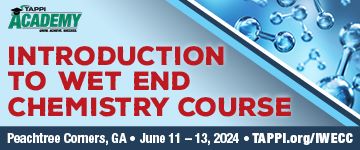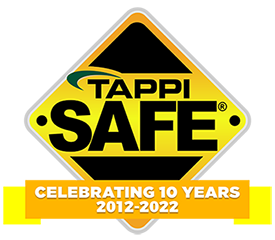 Search
Search
Use the search bar or filters below to find any TAPPI product or publication.
Filters
Content Type
Publications
Level of Knowledge
Committees
Collections
Journal articles

Magazine articles

Probing the molecular weights of sweetgum and pine kraft lignin fractions, TAPPI Journal June 2021
ABSTRACT: The present investigation undertook a systematic investigation of the molecular weight (MW) of kraft lignins throughout the pulping process to establish a correlation between MW and lignin recovery at different extents of the kraft pulping process. The evaluation of MW is crucial for lignin characterization and utilization, since it is known to influence the kinetics of lignin reactivity and its resultant physico-chemical properties. Sweetgum and pine lignins precipitated from black liquor at different pHs (9.5 and 2.5) and different extents of kraft pulping (30•150 min) were the subject of this effort. Gel permeation chromatography (GPC) was used to determine the number average molecular weight (Mn), mass average molecular weight (Mw), and polydispersity of the lignin samples. It was shown that the MW of lignins from both feedstocks follow gel degradation theory; that is, at the onset of the kraft pulping process low molecular weight-lignins were obtained, and as pulping progressed, the molecular weight peaked and subsequently decreased. An important finding was that acetobromination was shown to be a more effective derivatization technique for carbohydrates containing lignins than acetylation, the technique typically used for derivatization of lignin.
Journal articles

1998 tappi salary survey, TAPPI JOURNAL, August 1999, Vol. 82(8)
1998 tappi salary survey, TAPPI JOURNAL, August 1999, Vol. 82(8)
Magazine articles

Views from the top: ceos offer global perspectives on the pulp and paper industries, TAPPI JOURNAL, August 1999, Vol. 82(8)
Views from the top: ceos offer global perspectives on the pulp and paper industries, TAPPI JOURNAL, August 1999, Vol. 82(8)
Journal articles

Fibers properties and tearing resistance, TAPPI JOURNAL February 1988 88FEB103
Fibers properties and tearing resistance, TAPPI JOURNAL February 1988
Journal articles

Formulating to enhance the radiation cross linking of thermoplastic rubber for the hot-melt pressure-senstivie adhesives, June 1988, TAPPI Journal 88JUN155
Formulating to enhance the radiation crosslinking of thermoplastic rubber for hot-melt pressure-sensitive adhesives, TAPPI JOURNAL June 1988
Journal articles

Ethylene-carbon monoxide extrudable adhesive copolymers for polyvinylidene chloride, June 1988, TAPPI Journal 88JUN140
Ethylene-carbon monoxide extrudable adhesive copolymers for polyvinylidene chloride, TAPPI JOURNAL June 1988
Journal articles

Techniques for expanding the sphere of statistical process control, TAPPI JOURNAL July 1988
Techniques for expanding the sphere of statistical process control, TAPPI JOURNAL July 1988
Journal articles

The relationship between print mottle and coating structure, TAPPI JOURNAL May 1988 88MAY47
The relationship between print mottle and coating structure, TAPPI JOURNAL May 1988
Journal articles

Applying pilot coater results to mill practice, TAPPI JOURNAL May 1988 88MAY61
Applying pilot coater results to mill practice, TAPPI JOURNAL May 1988
Journal articles

Magazine articles

Control of malodorous gases emission from wet-end white water with hydrogen peroxide, TAPPI Journal October 2021
ABSTRACT: White water is highly recycled in the papermaking process so that its quality is easily deteriorated, thus producing lots of malodorous gases that are extremely harmful to human health and the environment. In this paper, the effect of hydrogen peroxide (H2O2) on the control of malodorous gases released from white water was investigated. The results showed that the released amount of total volatile organic compounds (TVOC) decreased gradually with the increase of H2O2 dosage. Specifically, the TVOC emission reached the minimum as the H2O2 dosage was 1.5 mmol/L, and meanwhile, the hydrogen sulfide (H2S) and ammonia (NH3) were almost completely removed. It was also found that pH had little effect on the release of TVOC as H2O2 was added, but it evidently affect-ed the release of H2S and NH3. When the pH value of the white water was changed to 4.0 or 9.0, the emission of TVOC decreased slightly, while both H2S and NH3 were completely removed in both cases. The ferrous ions (Fe2+) and the copper ions (Cu2+) were found to promote the generation of hydroxyl radicals (HOœ) out of H2O2, enhancing its inhibition on the release of malodorous gases from white water. The Fe2+/H2O2 system and Cu2+/H2O2 system exhibited similar efficiency in inhibiting the TVOC releasing, whereas the Cu2+/H2O2 system showed better perfor-mance in removing H2S and NH3.






